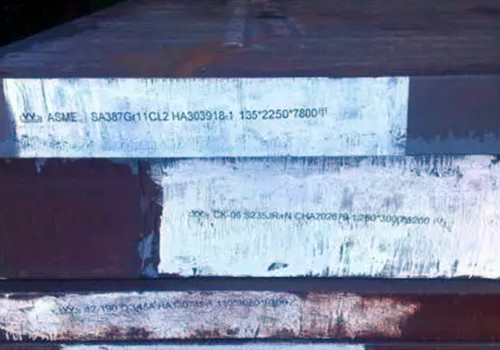As we all know, the strength of steel increases with the increase of carbon and manganese content, and the addition of Ti or Nb microalloying elements can obtain higher yield strength at low carbon equivalent. The high strength low alloy steels, HSLA for short, are engineering structural steels with a small amount of Mn, Si and trace of Nb, V, Ti, Al and other alloying elements added based on carbon structural steels. Low alloy means that the total alloying element in the steel is no more than 3% and high strength is relative to carbon structural steels. Low alloy high strength steel can bu used for engineering structure where need strength, reduce the weight and save material such as Bridges, ships, vehicles, high-pressure vessels, oil and gas pipelines, steel structures, etc, that does not need the complicated treatment process can obtain the higher strength, even does not carry on the heat treatment, can replace the general carbon structural steel most times.
The yield strength of low alloy high strength steels is close to the tensile strength, and the yield strength ratio is high, they will soon reach the tensile strength after reaching the yield strength; It has poor work hardening ability, the deformation part will continue to deform thinning and then produce fracture, so the forming performance is relatively poor. Therefore, it is suitable for the manufacture of structural parts and support parts that require higher stiffness. Generally speaking, typical parts manufactured with HSLA include rails, stiffeners, beams, chassis suspension parts, etc. However, if the yield strength ratio is too high and the structure is brittle failure, and there is no obvious deformation during the failure which is difficult to prevent, so it is not suitable for structural parts with seismic requirements.
The features of HSLA steel
High strength low alloy steel alloying elements was mainly used to produce solid capacity strengthening, fine-grain strengthening and deposition strengthening to improve the strength of the steel, at the same time use fine-grain strengthening the transformation of the steel ductile-brittle temperature are reduced, to offset the carbonitride precipitation strengthening of the steel. The transformation of steel ductile-brittle temperature this adverse effect, made of high strength steel and can maintain good performance at low temperature. The main characteristics of high strength low alloy steels are :
- High yield limit with good ductility and toughness
The most feature of low alloy high strength steels is their high strength. Under the condition of hot rolling or normalizing, the HSLA steel is generally 30% ~ 50% higher than that of the corresponding carbon engineering structural steels, so they can withstand large loads. The weight of the large engineering structure itself often becomes an important part of the load. The increase of steel strength can significantly reduce the weight of the component and further improve its ability to bear other loads, also greatly improves the compactness of engineering components, reduces the consumption of raw materials and the cost.
The elongation of HSLA steels ranges from 15% to 23%, and the impact absorption energy is >34 J at room temperature, with good plasticity and impact resistance, can avoid the occurrence of brittle fracture in the impact, making the cold bending, welding and other processing is easier. In addition, HSLA has a lower brittleness transition temperature which is beneficial for engineering components used in cold regions and for transportation vehicles such as vehicles, ships, offshore oil platforms, vessels, and Bridges.
- Good welding performance and atmospheric corrosion resistance
Engineering structure steel is required to have good weldability.HSLA steel has low carbon content and low alloy element content, good plasticity, and is not easy to produce quenching structure and crack in the weld area, and the addition of Ti, Nb, V can also inhibit the growth of grain in the weld area, so most of the steel has good welding performance and generally no heat treatment needed after welding. Most engineering structures are used in atmospheric or Marine environments. Adding a small amount of Cu, Ni, Cr, P and other elements into low alloy high strength steel can effectively improve its ability to resist atmospheric, seawater and soil corrosion. For example, 0.2%-0.5% copper, 0.05%-0.1% phosphorus and aluminum can significantly improve the corrosion resistance of steel, and the effect of adding copper and phosphorus at the same time is the best.
When the HSLA steel used in aircraft applications?
AISI 4340 is the earliest and typical grade of low alloy ultra-high-strength steel. The United States began to develop 4340 steel from the mid-1940s, by reducing the tempering temperature to make the tensile strength of steel up to 1600~1900MPa. In 1955 steel 4340 began to be used in the landing gear of the F-104 aircraft. The tensile strength of AISI 4130, 4140, 4330 or 4340 steel treated by quenching and tempering at low temperature can all exceed 1500MPa, and the notch impact toughness is high.
In order to restrain the tempering brittleness of low alloy ultra-high-strength steel, the 300M steel was developed by the International Nickel Corporation in 1952. 1~ 2% silicon was added to the steel to increase the tempering temperature (260~315℃) and to suppress the tempering brittleness of martensite. 300M steel has been widely used in the landing gear of aircraft since 1966. Military fighter jets such as F-15, F-16, DC-10 and MD-11 all use 300M steel. In addition, the landing gear of Boeing 747 and other civil aircraft and wing lapel and slat pipe of Boeing 767 aircraft also use 300M steel.
Although the low-alloy ultra-high-strength steels such as 4340 and 300M steels have high strength, their fracture toughness and stress corrosion resistance are poor, which limits their application in aircraft. D6AC steel, based on AISI 4340, is widely used in missile engine housings and aircraft structures. By the mid-1970s, D6AC gradually replaced other alloy structural steels and became special steel for solid rocket engine housings, landing gear and wing shafts.







